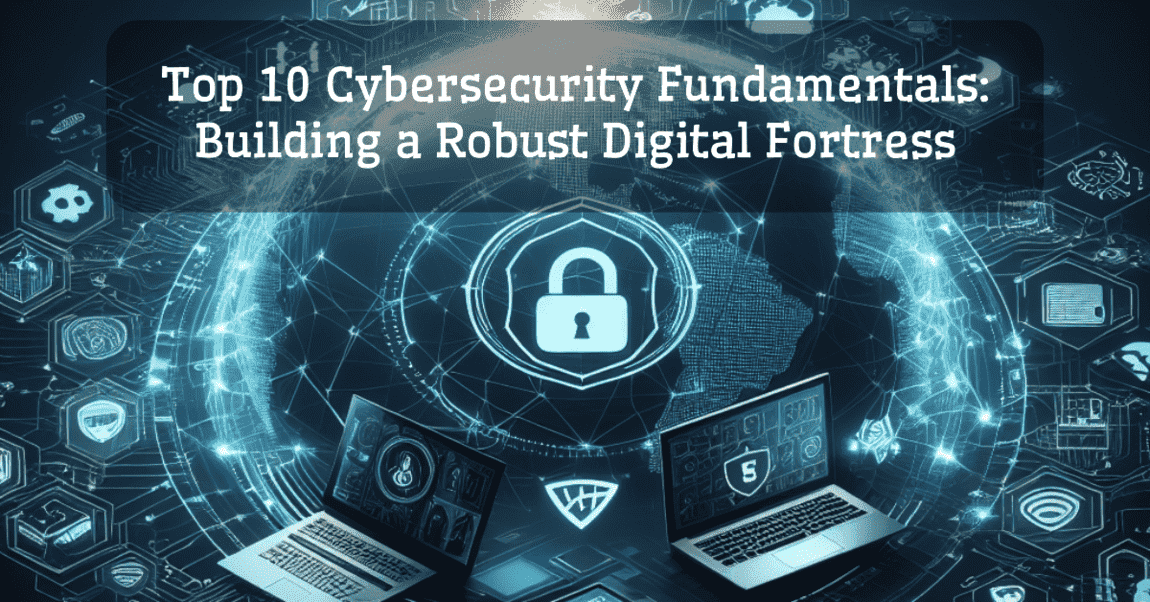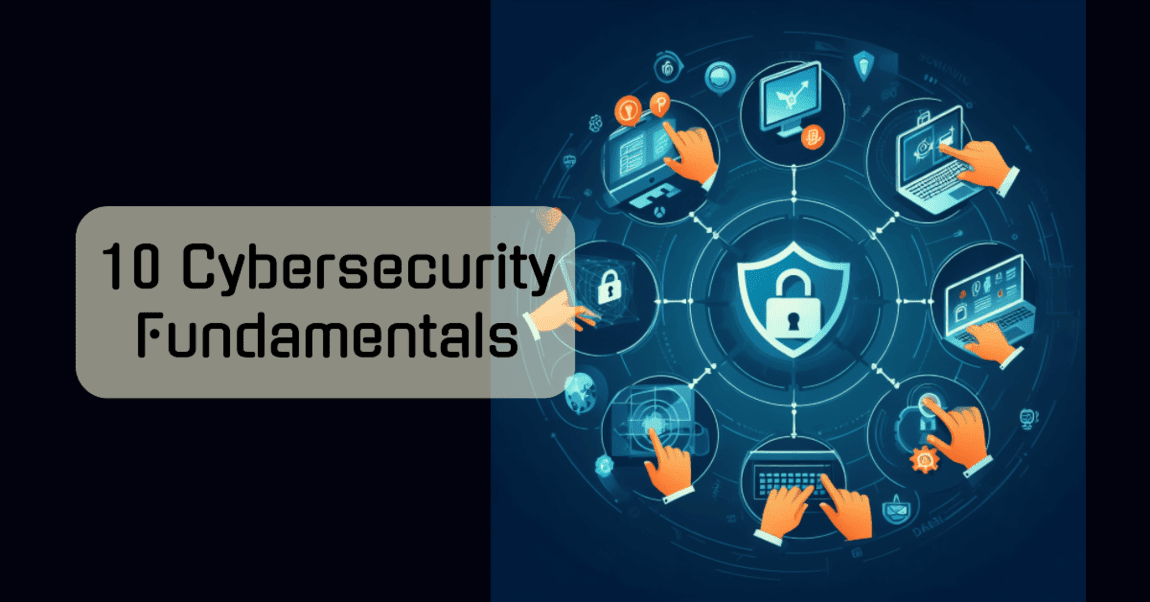Protecting against cyber threats is crucial in the digital age we live in. Learn the essential 10 Cybersecurity Fundamentals at TechyNerd, which are essential for a secure online environment. In today’s connected & constantly changing cyber terrain, arm yourself with the knowledge to navigate the digital world safely & safeguard what matters most.

What is Cybersecurity Fundamentals?
Cybersecurity Fundamentals entail understanding & defending against digital threats. It covers threat landscapes, incident response, info security principles, & asset protection. This knowledge aids in averting cyber-attacks, maintaining secure networks, & accessing relevant training courses for further understanding.
The fundamentals of cybersecurity are essential in today’s digital world. They include safeguarding systems & data from breaches & damage in addition to antivirus software. To protect people & organizations from various online threats, it is essential to comprehend these fundamentals.
What are some common cyber attacks?
In the realm of cyber threats, various types of attacks pose risks:
Malware
Malware, a combination of “malicious software”, purposefully disrupts networks & computers while compromising data. Violent Viruses, worms, Trojan horses, ransomware, spyware, & infiltrating systems to steal sensitive data are just a few of its many manifestations. Malware is used by cybercriminals to make money off of stolen financial & personal information.
Denial-of-Service (DoS) Attacks
A Denial-of-Service (DoS) attack disrupts a device’s normal functioning, rendering it inaccessible to users by overwhelming it with excessive requests. DoS attacks flood servers with traffic or exploit vulnerabilities, causing crashes & denial of service. Distributed Denial-of-Service (DDoS) attacks, originating from multiple sources, intensify the challenge of prevention. Notably, these illegal attacks inflict substantial harm on individuals & organizations.
Phishing
Phishing involves cyber attackers impersonating trusted entities to deceive victims into divulging sensitive details through emails, calls, or texts. They aim to steal valuable information or implant malware. Deceptive, targeted spear phishing, & whaling attacks aim to deceive individuals. Being aware & informed about phishing is crucial for self-protection against this prevalent cyber threat.
Spoofing
Spoofing, a fraudulent tactic in cyber security fundamentals, involves masquerading as a trustworthy source to deceive recipients into divulging sensitive data, spreading malware, or redirecting network traffic. With various forms like IP, ARP, email, website, & DNS spoofing, attackers exploit vulnerabilities, employing social engineering to exploit human emotions & lack of technical expertise.
Identity-Based Attacks
Identity-based attacks are an important component of cyber security fundamentals because they use credentials to infiltrate systems. Identity manipulation techniques that take advantage of access control vulnerabilities include credential stuffing, Kerberoasting, & MITM attacks. These attacks jeopardize system availability, data integrity, & confidentiality when they are carried out through social engineering or malware.
Code Injection Attacks
Malicious code is inserted into an application to take advantage of data handling vulnerabilities, according to the idea of code injection in cyber security fundamentals. Attackers compromise an application’s intended functionality by injecting harmful code & taking advantage of insufficient data validation. Attackers can run a variety of operations based on the capabilities of the injected language thanks to Code Injection, which is unrestricted by the command scope.
Supply Chain Attacks
Cyber security supply chain attacks involve taking advantage of software or services that are essential to the distribution chain by using vulnerabilities in reputable third-party vendors. By compromising physical components or introducing malicious code into applications, these attacks seek to infiltrate networks. Such security flaws, which are common in all industries, covertly add malicious components to products without being noticed to access control systems or sensitive data. This sophisticated strategy takes advantage of hardware & software vulnerabilities, defies conventional security measures, and is becoming more common in the changing cyber landscapes.
Insider Threats
Individuals with authorized access to a company’s systems pose both intentional & unintentional threats to cyber security. These threats involve intentional sabotage, espionage, or unintentional errors that compromise data or systems and are made by current or former employees or associates. Strong defenses must be put in place against intentional, unintentional, third-party, or malicious insider actions in order to prevent internal breaches that result in significant financial losses.
DNS Tunneling
DNS Tunnelling is a covert cyber attack approach that hides data within DNS queries and answers to influence distant servers & apps invisibly. Attackers use this method by sending DNS inquiries to their servers, taking advantage of the open nature of DNS requests to establish a covert communication channel. Because of the indirect link between attacker and victim, this permits data exfiltration or other malicious operations, making detection difficult. DNS Tunnelling, a long-used technique used by malware such as Morto & Feederbot, offers serious cybersecurity fundamental risks.
IoT-Based Attacks
IoT-based attacks target Internet of Things (IoT) electronic products, taking advantage of their occasionally lax security mechanisms. These attacks involve the use of IoT gadgets for unethical purposes such as encryption breaches, DoS, & indeed device takeover. With increased IoT interconnection, vulnerabilities grow, resulting in a wide range of troubles ranging from data theft to disruptive malware. As the use of IoT develops, so do the cybersecurity fundamental risks, which include network vulnerabilities and possible breaches, demanding powerful defense tactics from cybersecurity fundamental specialists specializing in cybersecurity basics.
Also Read: How Can an Attacker Execute Malware Through a Script? 5 Safety Tips
Do we need Cyber Security?
In today’s digital landscape, cybersecurity is indispensable. Our lives, entwined with the internet, span banking, shopping, communication, and entertainment, making us susceptible to cyber threats.

Reasons why cybersecurity is paramount:
Safeguarding Personal Data
Protecting vital information like banking details and addresses is pivotal to prevent identity theft.
Securing Business Information
Businesses harbor sensitive data, safeguarding intellectual property and personal details of employees and clients via cybersecurity Fundamentals.
Preventing Unauthorized Entry
Cybersecurity Fundamental tools ward off unauthorized access, shielding devices from viruses, spyware, and malicious software.
Sustaining Operations
Averted cyber attacks ensure uninterrupted day-to-day operations.
Regulatory Compliance
Compliance with industry regulations regarding information protection is ensured through cybersecurity measures.
Fostering Customer Trust
Prioritizing cybersecurity Fundamentals instills confidence in customers about the safety of their personal and financial data.
Also Read: Is Character AI Safe? 6 Important Safety Principle You Need to Know
Top 10 Cybersecurity Fundamentals

1. Understanding Cyber Threats
Knowledge about various cyber risks is vital. Malware, including ransomware & viruses, phishing attempts, DoS attacks, and other tactics can compromise systems & data. Recognizing these troubles is key to constructing effective defense strategies in Cybersecurity Fundamentals.
2. Securing Assets
Protecting an organization’s assets like networks & sensitive data is crucial. enforcing robust security measures, encryption, access controls, & regular backups ensures adaptability against possible hazards.
3. Information Security Fundamentals
Comprehending the core principles of information security is essential. This includes confidentiality, integrity, & availability (CIA), guaranteeing that data remains secure, unaltered, & accessible only to authorized users.
4. Security Operations & Response
Establishing an infrastructure for security operations & incident response is crucial. This involves creating plans & strategies to determine, respond to, and recover from security incidents effectively.
5. Social Engineering Awareness
Understanding social engineering tactics is vital. This includes recognizing manipulative strategies used by cybercriminals to extract sensitive information, frequently through psychological manipulation.
Also Read: How to Get Rid of Ultra Search Engine: 7 Effective Steps
6. Threat Actors Identification
Identifying implicit danger actors helps in understanding their motives & techniques. This insight assists in developing countermeasures & anticipating possible attacks.
7. Third-Party Risks
Admitting the hazards associated with third-party vendors or service providers is essential. Integrating strong security protocols & conducting regular assessments mitigates vulnerabilities from external sources.
8. Intelligence Sources Utilization
Exercising dependable intelligence sources provides critical perceptivity into arising troubles. This information helps in fortifying defenses & adapting security measures proactively.
9. Password Security
Promoting strong password practices involves creating & managing robust, unique passwords. executing multifactor authentication & regular password changes minimizes the threat of unauthorized access.
10. Safe Web Browsing Practices
Understanding online threats and rehearsing safe web browsing involves recognizing phishing attempts, avoiding suspicious links, updating software regularly, & being alert while collecting personal information online.
Also Read: How to Tell If Someone Is Accessing Your iPhone Remotely? 9 Sign & 10 Security Measures
Final Thought
Ultimately, embracing these top 10 cybersecurity fundamentals forms the backbone of a flexible digital defense system. In a quickly evolving digital sphere, remaining watchful & visionary serves as the linchpin to securing one’s online presence & navigating the ever-changing geography of cybersecurity troubles.
FAQ’s
What is the difference between cybersecurity and information security?
Cybersecurity focuses on protecting electronic communications, defending against malware and hacking threats, & protecting digital systems. It protects online data. Information security, on the other hand, extends beyond cyberspace to include safeguarding the availability, integrity, & confidentiality of all data across all platforms. Information security includes broader data protection facets, whereas cybersecurity is a subset of information security.
What is Cybersecurity Fundamentals Micro-credential?
Purdue University Global’s Cybersecurity Fundamentals Micro-credential is intended to give people the fundamental knowledge they need to pursue a career in cybersecurity. It provides a path to industry certifications like Network+ & Security+ by covering fundamental networking & security concepts. Key courses in the program, totaling between 23 & 25 credits, include Introduction to Cybersecurity, Networking With Microsoft Technologies, and Network Security Concepts. Students must carefully consider the state certification requirements for potential career paths.
Should Cybersecurity Fundamentals be a mandatory class in most high schools?
There are compelling arguments in favor of taking Cybersecurity Fundamentals in high schools. Its escalating applicability, promising career prospects, & useful life proficiency are highlighted by counselors. Curriculum overload, divergent student interests, & resource constraints are all matters of contention among opponents. The viability of the choice may depend on the availability of resources at the academy, the interests of scholars, & the particular requirements set forth by the educational system. The literacy opportunities of interested scholars could be met by offering it as a voluntary.
What are the five 5 basic principles of cyber security?
The essence of cybersecurity lies in five pivotal principles:
Confidentiality: Safeguarding information from unauthorized access, ensuring it’s only available to those permitted to view it.
Integrity: Protecting data from alterations during transit, ensuring it reaches its destination in its original form.
Availability: Ensuring authorized users can access data when needed by maintaining systems and swiftly addressing any disruptions.
Authentication: Verifying the identity of users through various means to prevent unauthorized access.
Non-repudiation: Guaranteeing that involved parties cannot deny a transaction, aided by digital signatures and timestamps.

